| Game Details | |
|---|---|
| Name | Memoir '44 (2004) |
| Complexity | Medium Light [2.28] |
| BGG Rank | 189 [7.54] |
| Player Count (recommended) | 2-8 (2) |
| Designer(s) | Richard Borg |
| Buy it! | Amazon Link |
Tally ho, what what! Time to get up and give Fritz a damn good hiding, wouldn’t you say? I’m Brigadier General Meeple Dicington-Hex and it’s my job to jolly well brief you lads on the art of war before we, which is to say, you, set off for Germany.
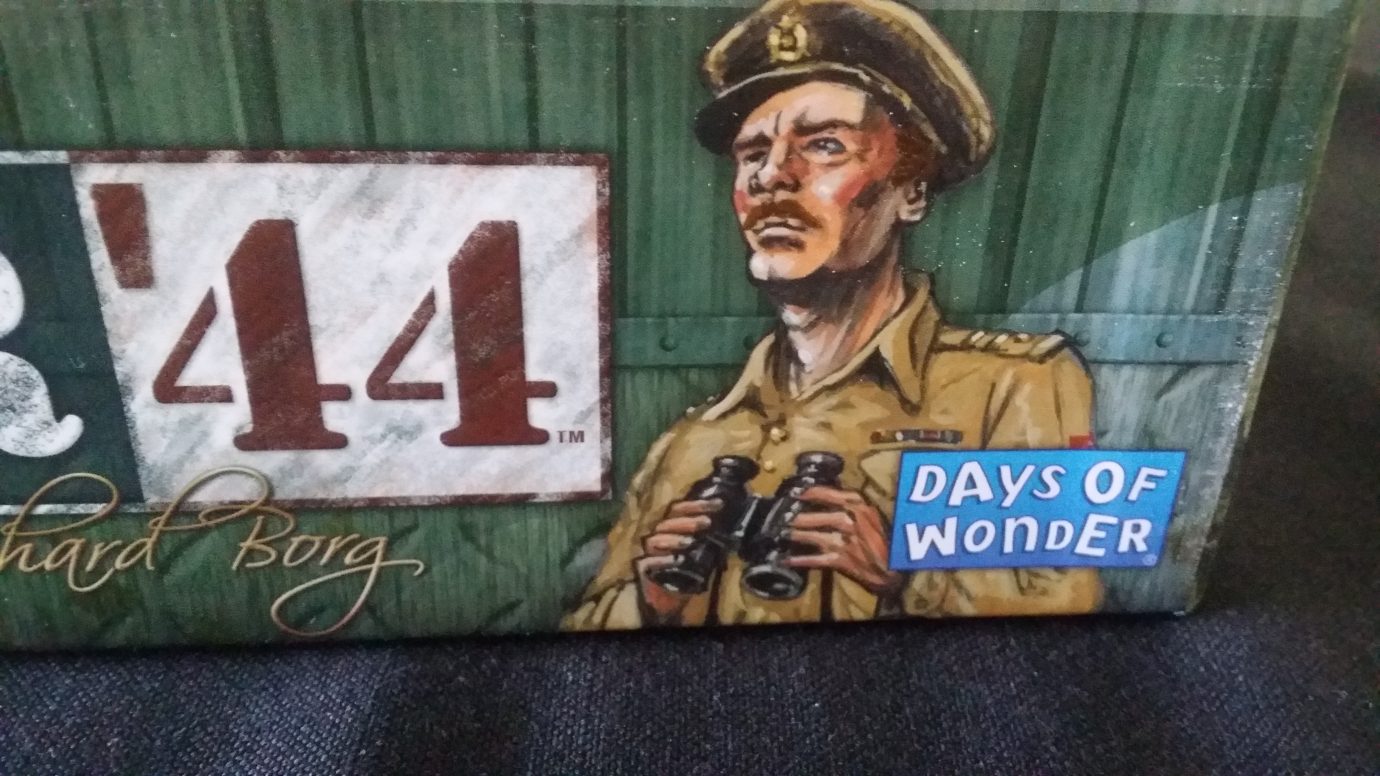
Ya boo, sucks to you Fritzy!
We’ll be doing that today with the help of this rather smashing piece of modern Allied technology. I believe the boffins down in the lab call it a ‘Cardboard Gaming Experience’. Those boffins what? One wonders what will they think of next.

War is hell
This rather fine box contains all you need to give the Bosche a good thrashing – at least if you can master the necessary brutalities of war. Mark my words, gentlemen – while this may seem like a lark, it’s serious business. A lot of you lads won’t make it back to mother. I’m awfully sorry, but that’s just the way it goes. But keep your chins up, keep those backs straight, and make sure you give the Hun what for! And now, I’ll leave you in the very capable hands of Sergeant-Major… Bulldog, was it? Is that your real name, Sergeant? It is? How very extraordinary. Anyway, I must be off. Tea with the Minister for War tonight, followed by a bracing night at the theatre. As you can see, I am no stranger to bloodshed myself, har har. So long, lads!

Don’t call me sir, I work for a living!
Right, now that he’s gone let’s talk about war. As much as it may look like it, Memoir ‘44 is not simply a game. Or rather, it is but one that has a surprisingly serious pedigree. It’s the official game of the 60th anniversary of the D-Day landings, and for good reason. War-games tend to be heavy duty affairs of meticulously calculating modifiers, plotting out range, and precisely modelling the various logistical, tactical and strategic factors that go into victory. Memoir ’44 is the diametric opposite of all that – a game which a rule-set that fits in a few slim pages, and hardly any contextual complexity in its turns. And yet within this approachable package it manages to find a place for all the drama and tension of the bloodiest battles of World War II.
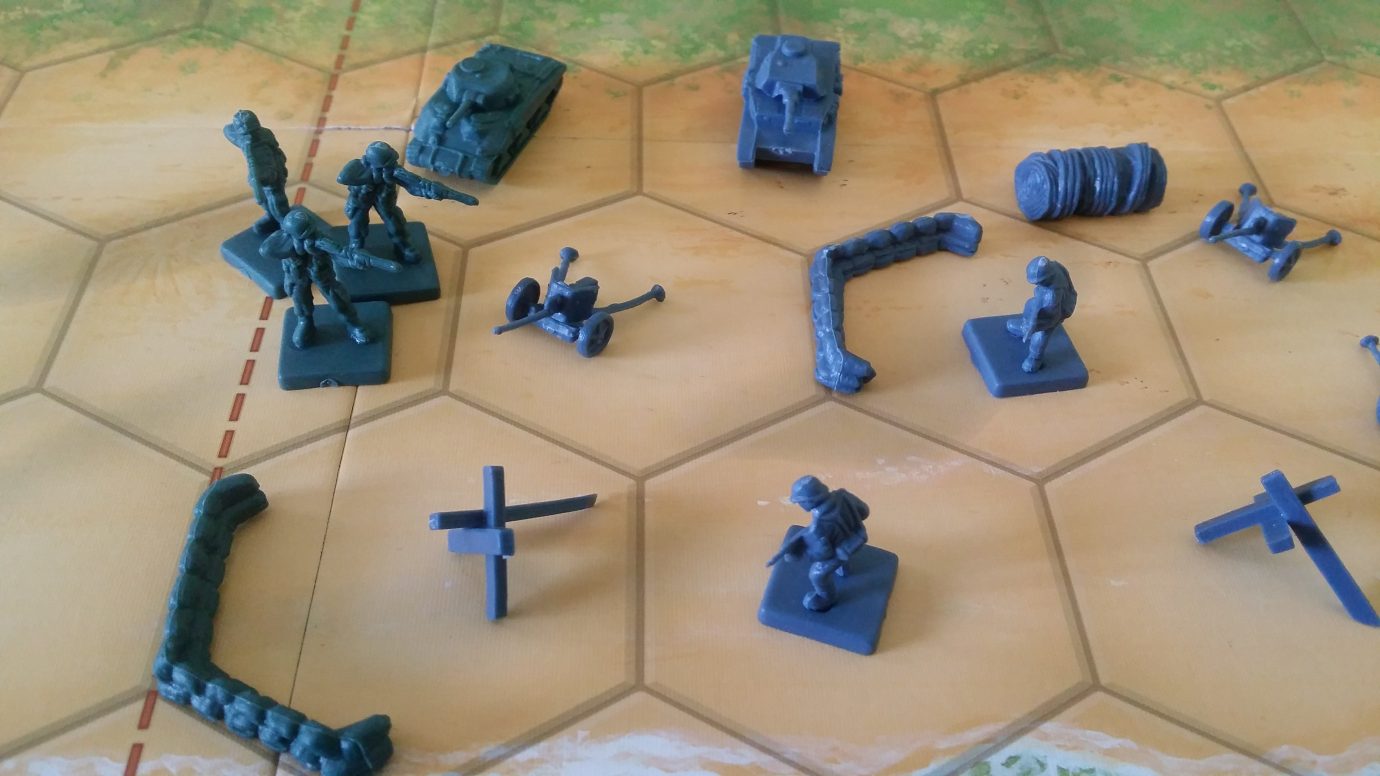
Deleted scenes from Band of Brothers
The game comes with a large six-fold board, which has a basic terrain printed on each side. One is a beach, and the other is grassy plain. On this map, we place various environmental features from a stack of hex tiles we are provided.

There’s been a pretty bad earthquake
The hex tiles allow us to indicate towns, forests, hills, hedges, rivers and so on. Each type of terrain has a few rules that distinguish it from the base of the map, and from each of the other kinds of terrain. None of these rules are especially complicated, but they lend a considerable degree of texture to the map and exert a significant impact on the way in which you wage your war.
When you open up the box, you’d be forgiven for heaving a sigh of reluctant exasperation as you take hold of the meaty manual. The good news is that most of the manual is content, rather than rules. The largest bulk of the book is made up of the sixteen base scenarios, and the one epic expanded scenario that requires a second copy of the game to play. It’s these scenarios that tell us how we should set up the map for certain famous historical encounters, and lend the game its strategic heft.

I say, these appear to be cheat codes to the war, General!
The one we’re going to look at in the review is Sword Beach, a battle from June 6, 1944. In the scenario guide, we are provided with bit of a historical lesson, a short briefing, a set of conditions for victory, and some special rules that pertain to this particular scenario.

Intel from the front
More importantly, we get the game map which shows the number and disposition of allied and axis forces along with the terrain we should use to flesh out the area. It can take a little time to set this up, but at the end you have the context for the battle you’re about to fight:

WW2 as seen via Google Earth
Memoir ‘44 is at its heart a two player game, but it also permits team modes where multiple players work together to control a particular side. The red lines indicate the sections of the map – each player has a centre, and two flanks. Troops that straddle a red line can be thought of as in either section as is convenient. Spread around the map are a number of hedgehogs – improvised barriers threaded through with anti-tank mines. Our armoured cars can’t pass those, although our infantry can merrily dance through with nary a worry. Well, nary a worry if you discount the artillery, tank shells and the screams of the dying rending the air.
We also have numerous barricades of wire strewn around – they’ll slow anyone down that tries to move through them, and get in the way of infantry attempting to engage in battle. And we also have our troops.

Dug in for the duration
In the top part of the map are the Germans – they have a regiment of armoured tanks and two battalions of infantry on their right flank. Remember, their right flank is our left flank. One of the infantry units is fortified in a bunker – they’re going to be difficult to shift.

Where are all the Germans? Is it a national holiday?
The centre contains a unit of infantry in a town, and a brace of artillery in a bunker. Depending on convenience, the infantry units straddling the red line can be considered part of the centre as well as part of the German player’s left flank. There’s another unit of infantry off in the corner, defending a town. We want to make sure the allies don’t get into those towns, because they’ll get victory points if they take ownership. The battle ends once one side has five of those.
And what about the allies? Well…

Scheisse!
Holy shit, right? The allies have nine units of infantry and three units of tanks – and the Germans have only six units of infantry and one unit of tanks. The Allies even have three units of special forces, who move with greater agility than their squaddie compatriots. The Germans have nothing equivalent in this battle. Who’d be a Nazi, am I right? It’s really put me right off fascism. I mean, there are probably other reasons to want to favour an Ally victory in World War 2, but surely the Axis are completely screwed here?
Well, no – the allies may have an overwhelming numerical advantage but the Germans are dug in like little ticks. Memoir ’44, like all good war-games, is not so much about numbers as it is about the ability to control the battle. Germany has three units in bunkers, and one of those units is a brace of artillery that will rain searing death on the allies from an astounding distance. Mark my words, the allies will have good cause to fear those shells before much time has passed.

And now a poem from Pte. Baldrick. It’s called ‘The German Guns’
The allies too will find it difficult to build up momentum because so many of them start in the ocean – troops can only move a single ocean square at a time. The beach will slow down the approach of the tanks, and the hedgehogs will funnel their movement. Simply mobilising troops to enter the battle is going to be tricky, and when it finally happens there’s every chance the Nazis can cut the Allies down with hails of gunfire before they can do anything useful.
Each side has advantages and disadvantages in the provided scenarios, but they are not necessarily equal. To deal with this, Memoir ’44 adopts a match-based system where once one leg is finished players switch sides and try again. The one with the largest victory point total at the end is the winner. That may sound like a horrendously time consuming chore, but battles in Memoir ’44 move at a surprisingly brisk pace.
In many miniature based games, such as the X-Wing Miniatures Game which we reviewed very recently, we must move every unit every turn and handle the combat between each. Memoir ’44 adopts a different system, providing each player with a deck of command cards that are used to issue troop movements.

This is the war, in its entirety.
It’s the command cards that are the engine of Memoir ’44 and also the thing that allows it to discard reams and reams of operational complexity. Each player gets a limited number of these cards, and each side won’t necessarily have the same number. The cards represent the logistics of World War II. In one neat mechanic, they encapsulate communication difficulties, superior tactical awareness, surprise and initiative and more. The thing that makes the game so tense and engaging is that you can’t command your troops with perfect precision. You can only command subsets of your troops, and if you don’t have a card that lets you command the right troops you’ll just have to bally well get on with it.
But more than this, while you draw new cards as you play, you never get to refresh your hand. As such, over time it can become clogged up with sub-optimal tactical choices unless you make an effort to keep something nice in reserve. In other words, in addition to representing operational complexity it *also* represents battle-weariness and attrition. God, it’s clever. Memoir ’44 is a clever game.

Eisenhower handed these to me for some reason.
For Sword Beach, the allies begin with five command cards available and the Nazis begin with four. The allies begin, and can play one card from their hand. Our allied player has several options – the green backed cards are ‘section’ cards and permit a set number of units to be commanded in given sections. The grey backed cards are ‘tactics’ cards and tend to offer more nuanced options that may stretch across the entire map.
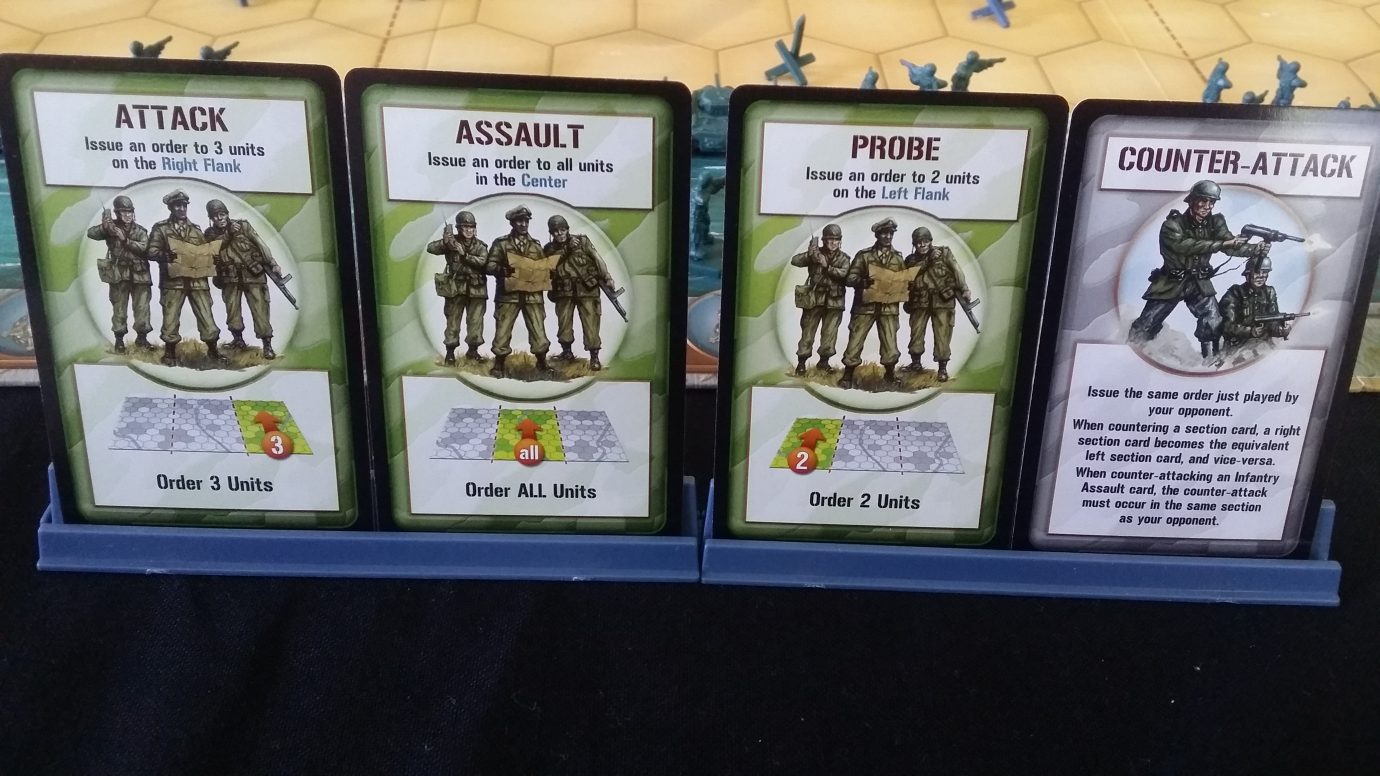
Das ist gut, ja?
The Germans have three section cards, permitting them to operate across all three regions of the map. They also have a ‘counter attack’ tactic which allows them to duplicate the last action played against them. That gives a fair bit of flexibility, and a degree of responsiveness. They may have fewer cards, but the cards are strong. The allies have two section cards, one for the right flank and one for the centre. They’re not going to be able to easily mobilise troops on the left flank for the moment. Perhaps the section commander was killed by a stray bullet, or communications are down. We don’t know, but it doesn’t matter – we do the job that’s in front of us with the tools we have available.
Each player’s cards are kept secret, so we’re never aware of what our opponent can actually do. Memoir ’44 is in part a game of watching your opponent to see where they’re weakest, and exploiting those weaknesses. Bear in mind though, each turn brings a new card into your opponent’s hand – weaknesses are not necessarily systemic. You need to work out when to take advantage, and when to hold back.
Wasting not a moment, the allies begin the battle with an armour assault. They only have three armoured units, so that’s all they get to move – any ‘left over’ orders are just wasted. If they didn’t have any armoured units, they could pick any unit anywhere on the map an issue it an instruction. Armour is powerful in Memoir – it can move as many as three hexes per turn, and at the end can fire at anything three hexes away, and roll three dice regardless of distance. They are, as Brigadier General Dicington-Hex might say, ‘an absolute bugger, what’. However, in this instance they’re moving over sand, and sand slows them down to a maximum of two hexes of movement:

My bed should be in there. Can’t get out of that in the morning. Hey-o!
It’s that damn beachhead – we’re trying to strike out from a position of weakness, and so we can’t push forward as hard as we might like. Our allied player moves all three armoured units, and advances them along the beach as far as they’ll go.

Onward, chaps!
Once all the units have moved, they can battle. Tanks can battle no matter how many hexes they move – infantry can move only one if they want to battle, but two if they don’t. We get to choose the order in which we resolve attacks, so we begin by issuing an order for our tanks on the right flank to blast at the infantry in the bunker. Send Fritz a message about messing with the boys from Blighty, rather!

You’d have as much luck throwing a flan at the bunker.
But here’s the thing – remember how I said the Germans were dug in like little ticks? That bunker hugely limits the effectiveness of armour fire against its occupants. Normally at that range a unit of armour would roll three dice. Unfortunately against a bunker, it rolls only one:
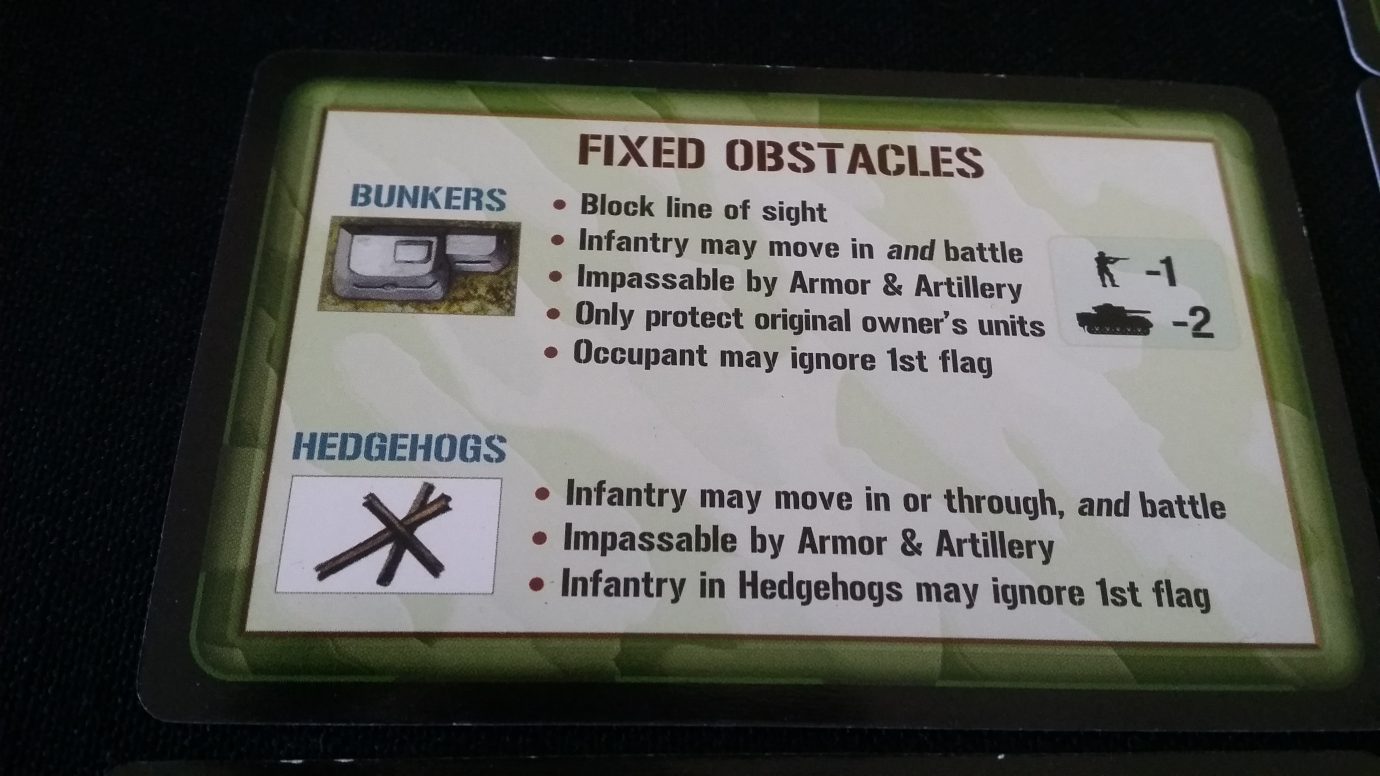
It looks nice, but it has lousy wi-fi
The allied player rolls a die to see what happens, and gets lucky:

I’m no history expert, but I believe real combat dice in World War 2 used red infantry symbols to indicate a kill.
The dice in Memoir ’44 are used to resolve combat, and they use a very simple system. If you roll an infantry, you kill one of their infantry. If you roll a tank, you kill oneof their tanks. If you roll a grenade, you kill one of whatever you were targeting. If you roll a star, nothing happens – these come into play with some tactics cards. We’ll talk about what happens when you roll a flag later.

The range of destruction
Having rolled an infantry, we remove one soldier from the bunker. This doesn’t reduce the effectiveness of the unit though – think of it like hit-points. Infantry are fragile – two of the sides on each d6 are infantry. There are lots of them in a unit though, so they might take some time to whittle down.

He was one day away from retirement!
Our other tank fires at the bunker on the left flank, and rolls a flag. This means ‘force a retreat’ – a unit has to move one space back towards their side of the map. If they can’t, they lose one of their number for each time they couldn’t. However, since the infantry are in a bunker, they ignore the first retreat flag that’s rolled. Yes… those bunkers are very handy, and even if you manage to clear the Nazi infestation the allies can’t make use of them in this scenario. Suddenly that numerical advantage doesn’t seem quite so useful, right? The allies hold the coastline, but the Germans hold the highlands. And they’re sharp. They’re sharp as knives.
Having played a card, issued the orders, and conducted the battle our allied general now draws a card to replace the one that was spent:

Hrm. I *was* planning to just hurl troops at them until they ran out of bullets, but I guess we could do this.
That one should be useful, one might think. Not only does it permit a flexibility of movement, it also removes a logistical weakness on the left flank.
The Nazis now get their turn, and choose to play an assault down the centre:

Jahwol!
They choose to move an infantry unit from the town to the side of the bunker, bringing it into the front line. If desired, the Nazis could also move the infantry units on the separating lines but choose not to. The bunker is too good to give up, and the Germans aren’t quite yet ready to go toe to toe with the armoured division on that flank.

Hey, can you let us in? It’s cold out here.
Now, the Germans open fire. Our bunkered infantry didn’t move, but they can shoot – at range two, they roll two dice. They get an infantry and a star, so nothing happens. But then, their artillery roars, ripping the air with its tectonic boom. It has a massive range of six hexes, and rolls 3/3/2/2/1/1 for those. At range three, it rolls two dice against the armoured tanks in the centre flank.

That’s some nice rollin’ private.
Ooft, that couldn’t have gone better really – the grenade kills anything and the tank symbol kills a tank. That unit is down to a single figure. If the allies lose that one, it is claimed as a trophy by the Nazis and becomes one of the five victory points they need to win. The other infantry unit can’t fire, since it moved two hexes. That’s the Nazi turn over. Der Fuhrer will be pleased at the job his men have done for the Fatherland.

Tanks for nothing, Germany
The allies play their second armoured assault, and move their tanks closer to the enemy:

Over the top, chaps!
Oh my, this is bad news for the Germans – tanks can mess up anyone’s day. The tank on the left flank moves into the barbed wire – it has to stop, but in the process it clears it away. Infantry units have to stop, and clear it away instead of a battle action – tanks do it for free. Tanks? You’re welcome!
Having moved, they open fire – a grenade and a retreat flag. The infantry unit loses a soldier, and is forced to retreat one hex towards the German side of the map. They slink back into the forest:

Tree’s Company
The tank in the centre opens fire, and crikey – it couldn’t have been any better:

Oh, that stings
A unit that had four soldiers in it now has only one – single additional fatality will destroy it and award the allies their first victory point.
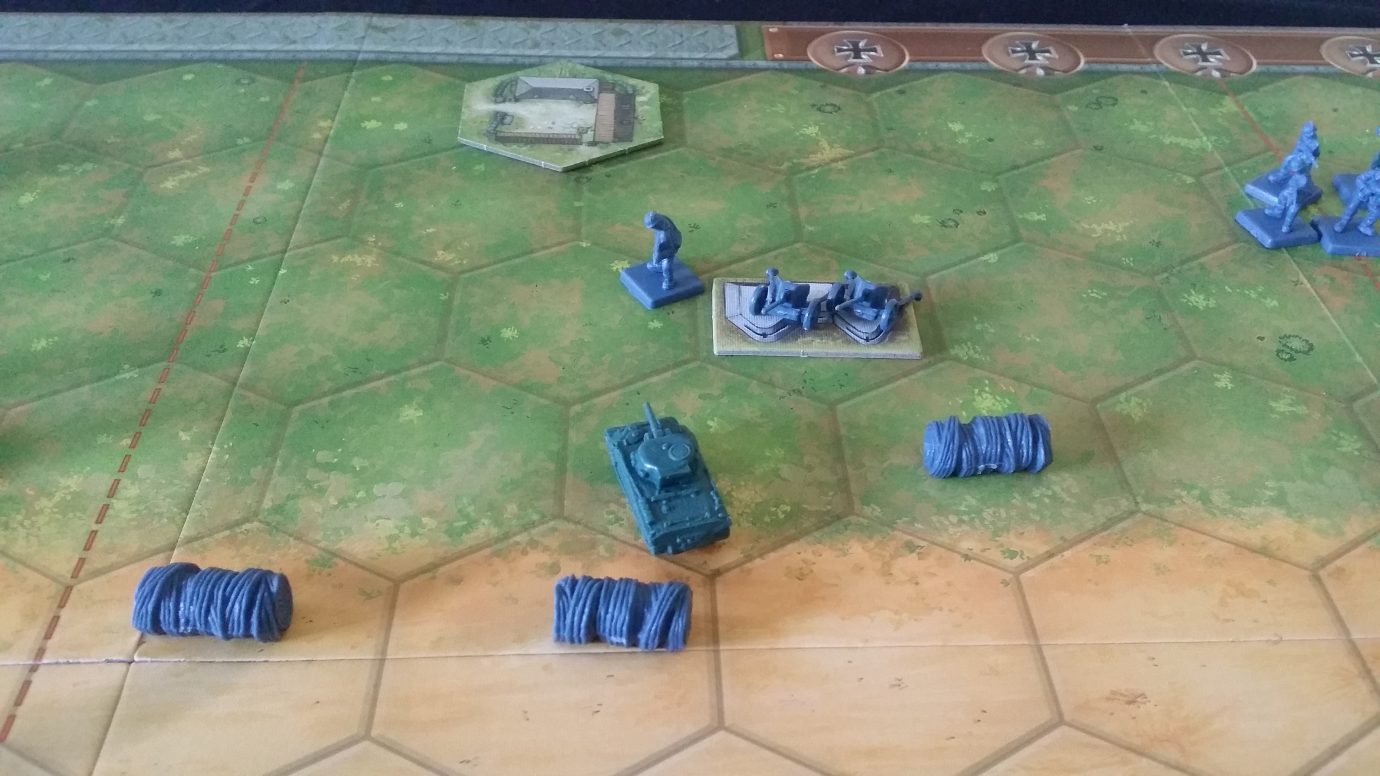
I know I said it was cold, but it’s heating up a fair bit out here. Could you let us in, please?
Our third tank fires away, and rolls three retreat flags. The unit they are targeting can retreat only one hex, and so has to lose two of their number to make up for it.

Try that one for size, Fritz!
All in all, a staggeringly successful assault from the allies. It will undoubtedly inspire some stirring oratory from Churchill back in Parliament. But things in Memoir ’44 turn on a sixpence – it’s a game of ebbs and flows, attacks and counterattacks. You’re dancing as much as you are fighting, as you absorb an attack down one flank and absorb its momentum as you drive an assault up the other. One shouldn’t become overconfident, because your success is built on a very flimsy foundation.
The Germans decide to attack on the right flank – which is to say, the left flank of the allied side. This is a side that hasn’t seen a huge amount of action so far except for some tank fire. The Nazis hope to regain the initiative here. They begin to mobilise their tanks, moving them into the forest – unfortunately, they have to stop there because of the terrain. They move the unit that retreated earlier back to where it was originally, and leave the bunkered infantry where they were. The bunkered unit opens fire with three dice at close range, rolling two infantry and a grenade. The armoured unit loses one tank. The unbunkered infantry fire with two dice, and get a tank and a grenade – and just like that, the tanks are gone and the Nazis have their first victory point. They claim the last tank figure, and place it on their medal track.

This medal may be too big to pin to your chest
And now, there’s nothing on the Allied left flank to cause the Germans any trouble. For now, at least. A moment’s respite has freed up some Nazi units for troublemaking if they want to make their way into the centre. Is that a good idea? It might be, although there are massed ranks of Allied soldiers still bobbing about in the sea, ready to wreck merry hell. It’ll take them time to make their way up the beach though, and a decisive attack might ensure they never have the opportunity to begin an assault.
Perhaps panicking at the sudden shift in the tone of the battle, the allies play Their Finest Hour – a very powerful card that gets more powerful the greater your logistical advantage.
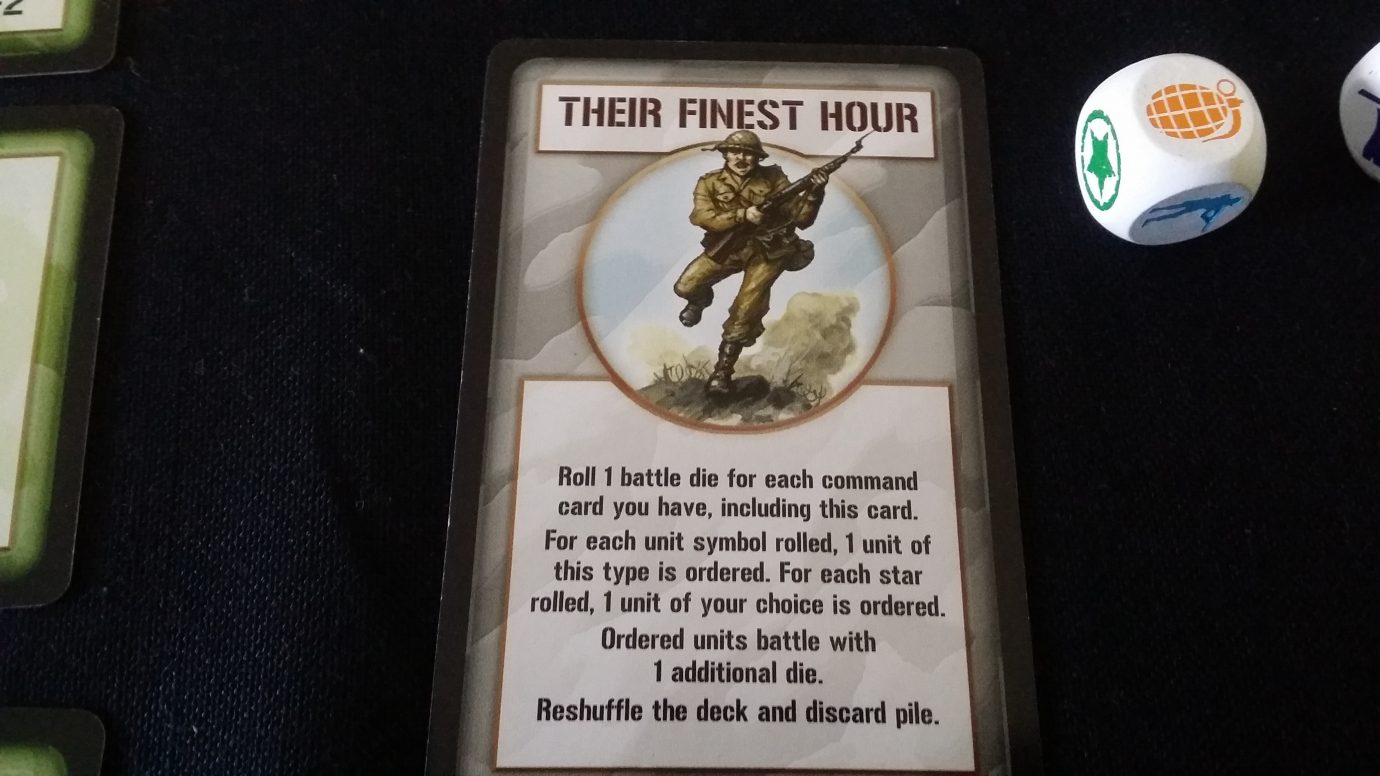
It’s a bit early in the battle to be making claims like this, guys.
They roll five dice, one for each of their command cards, and get two flags (ignored), a tank, an infantry, and a star. Here, the star means ‘And a unit of your choice’, so they’re going to be able to pick and choose which unit that’s going to be. More than that, when these units battle they get an extra dice! It really is their finest hour.
They move their tanks right up into the German’s grill, placing themselves in a position free of obstacles, and within striking distance of two towns. Yikes. They also take the opportunity to move an infantry units off of the sea and onto the beaches. The tanks fire, wiping out the two infantry units they’d targeted. Now the allies have two victory points, and the Nazis have only one.
Not able to see a powerful card like that go by without taking advantage of the opportunity, the Nazis order a counter attack. This gives them their own little shot of ‘Their Finest Hour’, although with only four dice rolled to indicate units. They roll well, letting them command a tank, two infantry units, and a unit of their choice. That unit is the artillery. Shells scream, guns chatter, men advance.
The allies begin an advance up the centre:

Charge!
And the Germans counter down their right flank. Their offensive throws the allies into retreat, forcing some of those that had managed to make it onto the beach back into the sea. The allies counter with a pincer movement, and the Nazis retaliate with an air assault. The allies order their infantry to move out, moving four of them into the fray from the beachhead.

Dolce et decorum est
And so on, and so on, and so on. Until the blood stains the sands and the water.
The action modulates agreeably throughout the course of each battle, rarely offering any side an insurmountable advantage. There’s a lot of luck in the dice rolls, but not as much as you’d think – so much more of the game is about clever positioning, commanding the terrain, and wise strategy. Success is far more dependent on your ability to keep the troops advancing and retreating in time with the battle. Eventually one side commands enough of the victory points to claim the win, and then both players swap sides and do it all again.
I’ve made mention above of how clever Memoir ’44 is with its command deck, and it really is. But clever doesn’t necessarily make for a genuinely good game. Clever can often get in the way of enjoyment, especially when it becomes a barrier to effortless play. The game systems are a barrier to fun until they’ve been internalised. Luckily, Memoir ‘44’s cleverness is all encapsulated away from you into the command deck, and even if you don’t appreciate just how smart that mechanic is you’ll benefit from it with every turn.
I’ll admit the world war theme left me cold from the very start. It’s not that I’m not interested in World War 2, because I am. It’s just that I don’t have any inherent desire to participate in its re-enactment. I’m also too jaded from the endless parade of World War 2 video games to relish the prospect of facing down the business end of a Jerry tommygun one more time. I bought the game because too many people with views I respect gushed about how excellent it was to ignore.
Just a few dice rolls in and I was putting on an exaggerated German accent and leaning into all the comic stereotypes of the Nazis I’d picked up from endless repeats of Allo Allo, It Ain’t Half Hot Mum and Dad’s Army. When I played the Allies, I lapsed into a kind of cross between General Melchett and Captain Fanshaw from Gary: Tank Commander. I had a blast, in other words.
For all its inherent simplicity, and it is a simple game, there’s a lot of meat here. You might think with a roster of only three unit types it’d be easy for the game to feel samey. Once again we encounter the genius of those command cards. Not only do they accomplish all kinds of clever design goals, but they actually create stories from the games you play. The narrative of the war above is all generated from played cards and the response they triggered. Your troops take on personalities based on their exploits, and you’re loathe to risk them. It doesn’t feel samey because each battle is telling you a different story.
If it was a game where you could simply command each unit in turn, Memoir ’44 would perhaps be the dullest game I could imagine. This single restriction of the command deck elevates it into the high echelons of design, elegantly illustrating the argument that creativity and ingenuity is shaped by constraint. You spend so little time worrying about the nuts and bolts of the game rules that you can just immerse yourself in the role of military tactician. The command deck presents you an ongoing, changing puzzle and one that I suspect you’ll never truly be able to fully master.
You need to be able to deal with a bad draw, although no hand is ever truly without merit. You also, and this is surprisingly challenging, need to be able to deal with a good draw. Use up your best material too quickly and you’ll find yourself outpacing the tempo of the battle. You might have a few turns of marvelous destruction only to find you’ve over-stretched your troops to breaking point. It can be a long road to get troops out of harm’s way. You can easily overplay your hand and be left with nothing that can save you as the enemy’s stranglehold tightens around your units. It’s important to bear in mind the power of victory points, and the need to deny them to your opponent. You need to have the logistical support to not only press home an attack but to rotate wounded units out of danger so as to deny your opponent the medal.
All of that said, it’s not a perfect game by any stretch. The scenarios lack any degree of cohesion, and it seems like there’s a campaign system, or even a legacy game, that is so close to the surface that it’s a shame nobody let it out. There is a campaign book you can buy, but it too doesn’t have quite the integrated oomph that Memoir ’44 is crying out for. Fair enough, this is a game from 2004 and as such long predates the current fashion for legacy board games. However, it’s also a game drawing from a rich tradition of campaign compatible war-gaming.
The match system, where you swap sides at the end, seems in many ways a compensation for fundamental imbalances in some of the scenarios – sure, that’s a consequence of a reasonably tight adherence to historical accuracy, but we’re not playing a text-book here.
While the logistical system of the command deck is wonderful, it doesn’t quite manage to gel with the actual game mechanics that are needed. Some of the tactics cards allow you to spend them to issue an order to any single unit, but it seems like that would have worked much better, and more consistently, as a free action anyone could take instead of playing a card. You’d still get all the benefits of operational complexity without completely screwing someone just because they don’t get the card they need to trigger their artillery when it would do the most good. You’d still be sacrificing an objectively superior alternative to take advantage of temporary conjunctions of circumstances. It would make the game feel a little more organic, and a little less abstracted.
I would have liked to have seen more opportunities for clever positioning – there are no adjacency bonuses for units, and no opportunity for units to flank others. If I attack from the rear, it confers no advantage. All of that ensures the game flows well and plays easily, but I found myself wishing for some rewards for carefully surrounding an opponent and then stabbing into their exposed rears.
Finally, and it’s going to need to wait for the teardown for a full discussion, it’s a pain in the backside to interact with the game. The colour scheme chosen is almost perverse, and the need to move multiple units around at a time, and sometimes around multiple obstacles, adds a huge layer of awkwardness. It’s an accessibility issue, but more than that it’s a basic playability issue. We spend as much time asking ‘Is that your unit or mine’ as we do actually playing. No word of a lie, when I put the game away after taking the photographs for this post I ended up mixing in the green units with the blue units because I couldn’t really tell which one was which.
But in the end, Memoir ’44 is an excellent game that manages to rise above its simple mechanics to become a deeply engaging strategic experience. It captures the thrilling storytelling of the best war fiction, without any of the complex rule-sets that go hand-in-hand with this genre of gaming. It’s genuinely approachable in a way so few titles of this type are. As such, we highly recommend you pick it up.
